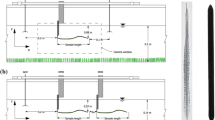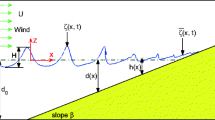Abstract
Though there is widespread agreement thatSpartina alterniflora marshes absorb some wave energy, there is considerable question regarding the magnitude and importance of this process. It has been suggested that marshes are much like an array of vertical cylinders in a water column. Based upon empirical estimates of the fluid drag forces occurring on vertical cylinders and laboratory observations of various arrays of cylinders, a model was developed to describe wave decay in marshes. In 1981, a series of field experiments were conducted to test and calibrate this empirical model in a series of naturalS. alterniflora marshes. The model with some modification was found to be very useful for describing wave decay in coastal marshes.
Similar content being viewed by others
Literature Cited
Benner, C. S., P. L. Knutson, R. A. Brochu, and A. K. Hurme. 1982. Vegetative erosion control in an oligohaline environment Currituck Sound, N. C., WETLANDS, The Journal of the Society of Wetland Scientists Vol. 2.
Camfield, F. E. 1977. A method for estimating wind wave growth and decay in shallow water with high values of bottom friction. CETA 77-6, U. S. Army, Corps of Engineers, Coastal Engineering Research Center, Fort Belvoir, VA.
Craig, N. J., and J. W. Day. 1977. Cumulative impact studies in the Louisiana coastal zone, eutrophication, land loss. Louisiana State University, Baton Rouge, NTIS Report No. PB-273 157/8ST.
Dean, R. G. 1978. Effects of vegetation on shoreline erosional processes. Wetland Functions and Values; The State of Our Understanding, Processing of the National Symposium on Wetlands. 415–426.
Dean, R. G. 1981, Personal communication. Professor, Department of Civil Engineering, College of Marine Studies, University of Delaware, Newark, DE
Dodd, J. D., and J. W. Webb, 1975. Establishment of vegetation for shoreline stabilization in Galveston Bay. MP 6-75, U.S. Army, Corps of Engineers, Coastal Engineering Research Center, Fort Belvoir, VA.
Garbisch, E. W., Jr., P. B. Woller, and R. J. McCallum. 1975. Salt marsh environment and development. TM-52, U.S. Army Corps of Engineers, Coastal Engineering Research Center, Fort Belvoir, VA.
Gleason, M. C., D. A. Elmer, N. C. Pien and J. S. Fisher. 1979. Effects of stem density upon sediment retention by Salt Marsh Cordgrass,Spartina alterniflora Loisel. ESTUARIE, Journal of the Estuarine Renearch Federation, Vol. 2., No. 4 271–273.
Gosselink, J. G., E. P. Odum, R. M. Pope. 1974. The value of tidal marsh. Center for Wetland Resources, Publ. No. LSU-SG-74-03, Louisiana State University, Baton Rouge, LA.
Hershner, C, and K. Moore. 1977. Effects of the Chesapeake Bay oil spill on salt marshes of the lower bay. Oil Spill Conference Proceeding, New Orleans, LA. Marsh 8–10, p. 529.
Knutson, P. L., J. C. Ford and M. R. Inskeep. 1981. National Survey of planted salt marshes (vegetative stabilization and wave stress), WETLANDS, The Journal of the Society of Wetland Scientists, September, 1981, Vol. 1, ISSN 0277-5212.
McGoldrich, L. F. 1969. A method for the generation and measurement of capillary gravity waves. Department of the Geophysical Sciences, University of Chicago, Technical Report No. 3. Office of Naval Research, Contract No. Navy N00014-67-A-0285-0002.
Munk, W. N., 1949. The solitary wave theory and its application to surf problems. Annuals of the New York Academy of Science, Vol. 81, pp. 376–462.
Nixon, S. W., and C. A. Oviatt. 1973. Analysis of local variation in the standing crop of “Spartina alterniflora”. Rhode Island University Kingston Graduate School of Oceanography, NTIS Repot No. Com-74-10052/1.
Phillips, W. A., and F. D. Eastman. 1959. Riverbank stabilization in Virginia. Journal of Soil and Water Conservation, 14: 257–259.
Reimold, R. J. and R. A. Linthurst. 1977. Primary productivity of minor marsh plants in Delaware, Georgia and Maine. TR: D-77-36, U.S. Army, Engineering Waterways Experiment Station, Vicksburg, MS.
Shabman, L. A. and S. S. Batie. 1979. Estimating the economic value of coastal wetlands: conceptual issues and research needs. Paper presented at the International Estuarine Research Conference, Jekyll Island, Ga. October 7–12.
Sharp, W. C., and J. Vaden. 1970. Ten-year report on sloping techniques used to stabilize eroding tidal river banks. Shore and Beach. 38: 31–35.
Sorensen, R. M. 1973. Water waves produced by ships. Journal of the Waterways Harbor and Coastal Engineering Division, ASCE, Vol. 99, No. WW2. Proc. Paper 9754, 274–256.
Turner, R. E., and J. G. Gosselink. 1975. A note on standing crops ofSpartina alterniflora in Texas and Florida. Contribution in Marine Science, 19: 113–118.
U.S. Army, Corps of Engineers, Coastal Engineering Research Center. 1977. Shore Protection Manual. Third edition, Vol. 1,2,3. U.S. Army Corps of Engineers, Coastal Engineering Research Center, Port Belvoir, VA pp. 1,262.
Wayne, C. J. 1975. Sea and marsh grasses: Their effect on wave energy and nearshore transport. M. S. Thesis, Florida State University, College of Arts and Sciences, Tallahassee, FL.
Williams, R. B. and M. B. Murdoch. 1969. The potential importance ofSpartina alterniflora in conveying zinc manganese and iron into esturarine food chains. In: Proc. 2nd National Symposium on Radiology.
Woodhouse, W. W., Jr., D. E. Seneca, and S. W. Broome. 1974. Propagation ofSpartina alterniflora for substate stabilization and salt marsh development. TM-46, U.S. Army, Corps of Engineers, Coastal Engineering Research Center, Fort Belvoir, VA.
Woodhouse, W. W., Jr., D. E. Seneca and S. W. Broome. 1976. Propagation and use ofSpartina alterniflora for shoreline erosion abatement. TR 76-2, U.S. Army, Corps of Engineers, Coastal Engineering Research Center, Fort Belvoir, VA.
Author information
Authors and Affiliations
Rights and permissions
About this article
Cite this article
Knutson, P.L., Brochu, R.A., Seelig, W.N. et al. Wave damping inSpartina alterniflora marshes. Wetlands 2, 87–104 (1982). https://doi.org/10.1007/BF03160548
Issue Date:
DOI: https://doi.org/10.1007/BF03160548




